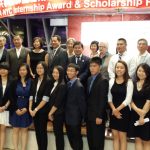CUP Fellows Program: Deadline Nov. 22

Dear CUP Members & Friends,
The Council of Urban Professionals (CUP) is seeking dynamic emerging leaders from the business, consulting, digital and technology, finance, legal, media and entertainment, and non-profit and public sectors for its CUP Fellows Program. Powered by American Express, the CUP Fellows Program is entering into its seventh year.
CUP Fellows are talented and visionary, multicultural and women professionals, aged 25 to 45, with the passion to become powerful leaders in their community. Through the CUP Fellows program, participants complete a rigorous ten month leadership development experience that includes skills-based training, networking events, and board placement services that prepare them for impactful civic involvement.
There is no greater experience than being a CUP Fellow!
In addition to equipping professionals with the skills needed to lead with impact, the CUP Fellows Program provides participants with a lifelong springboard for prestigious opportunities such as appointments to nonprofit and public sector boards. By exposing CUP Fellows to public sector opportunities and an influential network of professionals, the program is designed to equip participants with the skills, information, and resources needed to manage their careers effectively and position themselves for leadership opportunities.
PROGRAM PARTICIPANT PERKS
- Capstone Experience: The Capstone Project is a significant part of the CUP Fellows experience. The purpose of the project is to give the Fellows the opportunity to apply the leadership and professional skills learned throughout the program to a real-life organizational challenge in the non-profit sector.
- CUP Board Matching Program: Through CUP’s “A Seat at the Table” initiative, we secure strategic board and career matches for CUP Fellows, fulfilling our vision of increasing the diversity of boardrooms and enhancing the capacity of organizations to better serve our communities.
- CUP Executive Level Membership: At the conclusion of the program, CUP Fellows receive a one-year CUP Executive Level membership. This membership gives access to members-only receptions, networking opportunities, leadership development forums and more.
APPLICATION AND INTERVIEW INFORMATION:
To apply, please click here to carefully read the application process details, including information about the eligibility requirements and supplemental application materials.
All CUP Fellows Program applicants must complete the application form and submit the following supplemental materials:
- Resume
- Statement of Intent
- Essay
- Letter of Recommendation
Please let us know if you have any questions and we look forward to receiving your application materials.
Best regards,
Avital Tamir, Director of Programs, CUP Leadership Institute
From CUP: Meet the Candidates for New York City Comptroller

The Council of Urban Professionals
Wednesday, September 4, 2013
BakerHostetler
____________________________________________________________________
The Council of Urban Professionals (CUP) connects, empowers, and mobilizes the next generation of diverse business and civic leaders. Founded in 2007, CUP is a 21st century leadership development organization with over 1,500 individual members, a national network of 20,000, and 65 corporate partners spanning the financial services, law, media & entertainment, digital & technology, healthcare, consumer packaged goods, and non-profit and public sectors. Through a series of forums, leadership development programs, and peer networks, CUP empowers aspiring diverse professionals to develop connections, opportunities, and expertise that best position them for top leadership positions, resulting in transformative impact on our communities.
From APIAVote: Census Analysis of Asian American Electorate

June 7, 2013
Add 500,000 New Voters
- The growth of the Asian American electorate was relatively steady between 2004-8 and 2008-12 (an increase of about 589,000 and 547,000 in each period). By contrast, the number of white voters rose by about 475,000 between 2004-8, and declined by about 2 million between 2008-12.
- The biggest growth in the Asian American electorate was between 2000 and 2004, with 723,000 new voters. However, 2004 was also a year that saw an increase of 10 million white voters, thereby muting the electoral affect of Asian American’s growth.
- The Asian American share of the voting population has been steadily increasing, from 1.8 percent of all voters in 2000 and 2.2 percent in 2004, to 2.6 percent in 2008, and 2.9 percent in 2012.
- Voter registration remains a significant hurdle for Asian Americans, with only 56 percent of adult citizens registered to vote in 2012. This compares to registration rates of 72 percent and 73 percent among whites and blacks, respectively, and 59 percent among Latinos.
- Once registered, however, Asian Americans turn out in rates comparable to other groups: 84 percent for Asian Americans, 82 percent for Latinos, 87 percent for whites, and 91 percent for blacks.
For more information on this growing electorate, “Behind the Numbers” is available at: http://www.apiavote.org/sites/default/files/btn_final_singles_FINAL_0.pdf.
Further details from the census report can be found at
http://www.apiavote.org/sites/default/files/Census%202012%20Voting%20Rates.pdfAbove and Beyond: Honoring Women of Public and Civic Mind
Wednesday, February 8, 2012
Pace University, 3 Spruce Street, New York, NY
5:00pm to 6:30pm (Panel discussion followed by a brief Q & A)
Reception: 6:30pm to 8:00pm (Cocktail/Dinner Reception & Awards Ceremony)
Pace University invites you to join them for an evening forum featuring knowledgeable, influential New York women discussing leadership and tips on how to succeed in the public and civic space. A dinner and cocktail reception immediately follow to honor 25 women for their exemplary work and service in business, community service, media, public service and organized labor.



